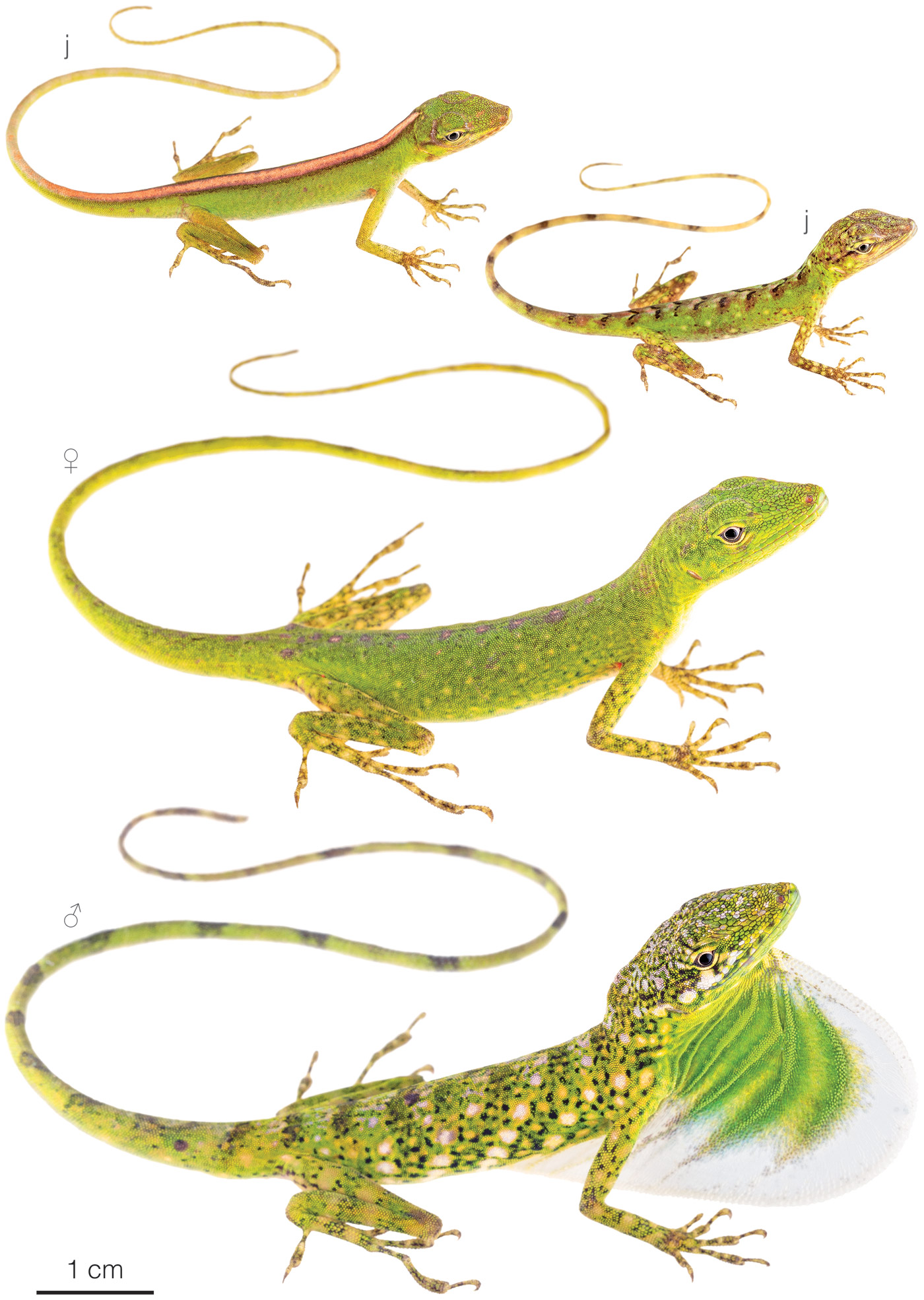Published June 30, 2023. Updated October 29, 2023. Open access. | Purchase book ❯ |
Poe’s Anole (Anolis poei)
Reptiles of Ecuador | Sauria | Anolidae | Anolis poei
English common names: Poe’s Anole, Telimbela Anole.
Spanish common name: Anolis de Poe.
Recognition: ♂♂ 21.9 cmMaximum distance from the snout to the tip of the tail. Snout–vent length=6.0 cm. ♀♀ 22.0 cmMaximum distance from the snout to the tip of the tail. Snout–vent length=5.8 cm..1 Anoles are easily distinguishable from other lizards by their diurnal habits, extensible dewlap in males, expanded digital pads, and granular scales on the dorsum and belly. The Poe’s Anole (Anolis poei) can be identified from other co-occurring anoles based on its small size, green dorsum, and its dewlap coloration consisting of a central patch of green bars on an uniformly white background (Fig. 1).1 Females of A. poei differ from males and from females of other cloud forest anoles by lacking a dewlap and by having a solid green dorsum with the occasional pale mid-dorsal stripe.1 The morphologically similar A. gemmosus occurs north of the known distribution of A. poei.2

Figure 1: Individuals of Anolis poei from Cascada de Angas, Bolívar province, Ecuador. j=juvenile.
Natural history: Anolis poei is one of four anole species that are commonly found in the cloud forests of Bolívar province.1 The species inhabits old-growth cloud forests as well as forest edge, riparian forest, and pastures with scattered bushes.1,3 This species seems to occur in higher densities along semi-open habitats rather than in close-canopy situations. Poe’s Anoles are active during cloudy and sunny days on stems and ferns in the cloud forest understory.3 At night, they prefer to sleep on flimsy perches that will move if disturbed by a predator, including leaves, ferns, lianas, and vines 50–450 cm above the ground.1,3 Nothing is known about reproduction in this species, but anole lizards in general lay clutches of a single egg.
Conservation: Endangered Considered to be facing a high risk of extinction in the near future.. Anolis poei is proposed to be listed in this category, instead of Data Deficient,4 on the basis of the species’ extremely limited extent of occurrence (estimated to be under 200 km2), the low number of extant populations (=3), and the ongoing loss of cloud forest in its area of distribution. Most of the habitat of A. poei has already been converted to pastures and agricultural fields, an environment in which the species does not survive. Furthermore, Poe’s Anoles have not been recorded in any of Ecuador’s national parks.
Distribution: Anolis poei is endemic to the Pacific slopes of the Andes in west-central Ecuador (Fig. 2).

Figure 2: Distribution of Anolis poei in Ecuador. The star corresponds to the type locality: Telimbela, Bolívar province. See Appendix 1 for a complete list of the presence localities included in the map.
Etymology: The generic name Anolis is thought to have originated from Cariban languages, specifically from the word anoli, which is the name Arawak peoples may have used to refer to this group of lizards.5 The specific epithet poei honors American herpetologist Steve Poe, in recognition of his contributions to the systematics and evolution of Anolis lizards.1
See it in the wild: Poe’s Anoles can most easily be located at night by using a headlamp to scan low riparian vegetation. These lizards usually sleep on exposed surfaces and adopt a shining green coloration while roosting. The species is not uncommon in the cloud forests of Bolívar province, but individuals are becoming harder to procure.
Special thanks to Alain Kormann for symbolically adopting the Poe’s Anole and helping bring the Reptiles of Ecuador book project to life.
Click here to adopt a species.
Author: Alejandro ArteagaaAffiliation: Fundación Khamai, Reserva Arlequín, Ecoruta Paseo del Quinde km 56, Santa Rosa de Mindo, Pichincha 171202, Ecuador.
Photographer: Jose VieirabAffiliation: Tropical Herping (TH), Quito, Ecuador.,cAffiliation: ExSitu, Quito, Ecuador.
How to cite? Arteaga A (2023) Poe’s Anole (Anolis poei). In: Arteaga A, Bustamante L, Vieira J (Eds) Reptiles of Ecuador: Life in the middle of the world. Available from: www.reptilesofecuador.com. DOI: 10.47051/MVRA7317
Literature cited:
- Ayala-Varela FP, Troya-Rodríguez D, Talero-Rodríguez X, Torres-Carvajal O (2014) A new Andean anole species of the Dactyloa clade (Squamata: Iguanidae) from western Ecuador. Amphibian & Reptile Conservation 8: 8–24.
- Arteaga A, Bustamante L, Guayasamin JM (2013) The amphibians and reptiles of Mindo. Universidad Tecnológica Indoamérica, Quito, 257 pp.
- Field notes, Reptiles of Ecuador book project.
- Yánez-Muñoz MH, Cisneros-Heredia DF (2020) Anolis poei. The IUCN Red List of threatened species. Available from: www.iucnredlist.org. DOI: 10.2305/IUCN.UK.2020-3.RLTS.T75100692A75100955.en
- Allsopp R (1996) Dictionary of Caribbean English Usage. Oxford University Press, Oxford, 776 pp.
Appendix 1: Locality data used to create the distribution map of Anolis poei in Ecuador (Fig. 2). Go to the section on symbols and abbreviations for a list of acronyms used. Asterisk (*) indicates type locality.
| Country | Province | Locality | Source |
| Ecuador | Bolívar | Cascadas de Angas, 1.9 km E of | This work; Fig. 1 |
| Ecuador | Bolívar | Recinto Tres Cruces | Ayala-Varela et al. 2014 |
| Ecuador | Bolívar | Telimbela, 3 km E of* | Ayala-Varela et al. 2014 |